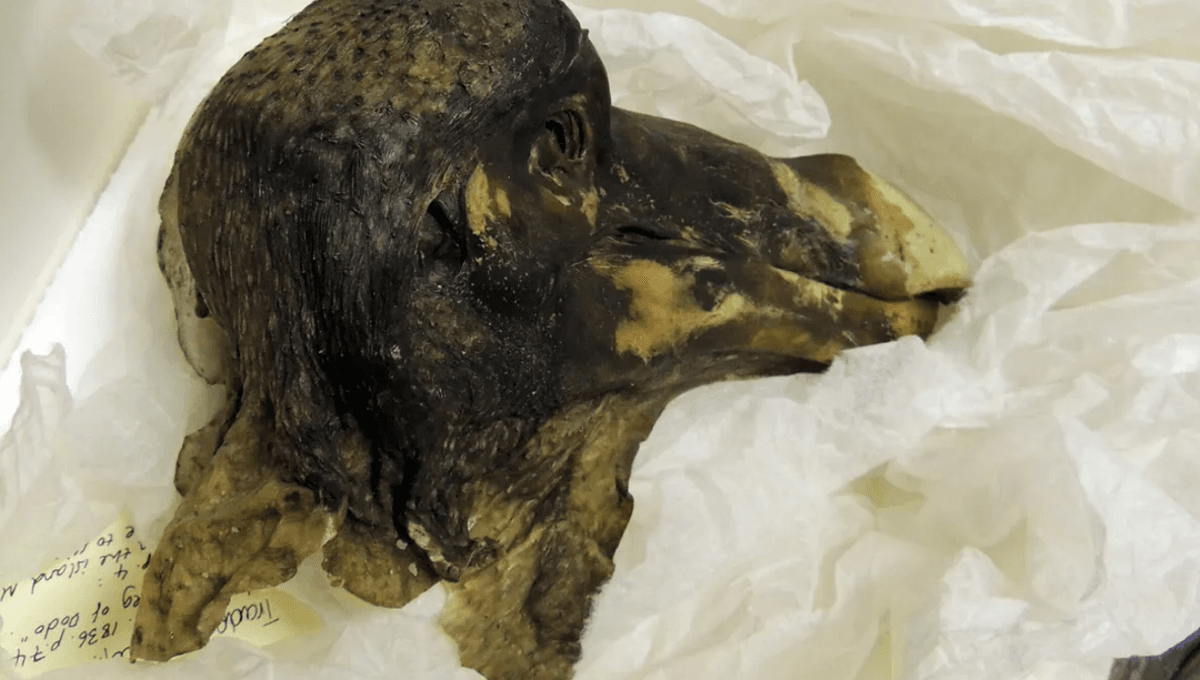
The dodo has become an enduring symbol of humanity’s role in driving species to extinction. By the late 17th century, European colonizers had wiped this flightless bird from the planet. Practically nothing of the species now remains – except for a fascinating specimen at the Oxford University Museum of Natural History.
The so-called “Oxford Dodo” boasts the honor of being the only surviving remains of dodo soft tissue in the world. The specimen consists of a skull with leathery skin still on its left side, as well as various tissue samples, a sclerotic ring from the eye, a feather, a foot bone, and part of its femur.
The specimen was first recorded in Oxford in 1683, when the bird was largely intact. By 1755, however, much of it had deteriorated beyond preservation and had to be destroyed, leaving only the head and a single foot.
Still, the remains are in such good condition that scientists have even managed to obtain DNA from the tissues. In 2002, scientists at the University of Oxford used genetic samples from the specimen to shed more light on the origin of the dodo. Their work revealed that the species belonged to the group of birds that includes pigeons and doves, known as Columbiformes.
The dodo’s closest living relative was found to be the Nicobar pigeon (Caloenas nicobarica), which inhabits the Andaman and Nicobar Islands on the other side of the Indian Ocean from the dodo’s homeland in Mauritius. They were also very closely related to the Rodrigues solitaire (Pezophaps solitaria), a native of the small island of Rodrigues near Mauritius that fell into extinction by the late 18th century.
Another fascinating insight into the life of the “Oxford Dodo” emerged when scientists applied forensic scanning technology to the remains. This showed that the individual was killed with a gunshot wound to the neck and head. It remains unknown who pulled the trigger, however.
Dodos stood at around 1 meter (3 feet) tall and weighed about 20 kilograms (44 pounds). Paintings and drawings from their time portrayed the big-beaked birds as plump and rotund, but researchers now believe they were much slimmer than these depictions suggest. That said, we can never truly understand what they looked like without living examples.
Their fate was sealed when Europeans arrived in Mauritius during the age of colonization. The first written mention of the dodo came from Dutch sailors in 1598, although there’s some speculation that they were previously spotted by the Portuguese (who may have mistaken them for penguins).
As chilled-out, flightless birds that nested on the ground, the species became easy targets for hunters, as well as the predatory animals they introduced to the island, like dogs, cats, pigs, rats, and crab-eating macaques. Their population was quickly decimated. The last confirmed sighting of a live dodo was in 1662, although statistical analysis suggests they held on to survival as late as 1690.
A few dodo bones can be found in several different museums around the world, but the “Oxford Dodo” is the only known example of intact soft tissue. And by the way, if you’ve ever seen an exhibition featuring a stuffed taxidermy dodo, there’s a good chance it’s not entirely genuine – many are reconstructed models, often made using parts from other birds like chickens and pigeons.
An earlier version of this article was first published in October 2023.
Source Link: The Last Remaining Soft Tissues Of A Dodo Date To 1683 CE – And Are Still Going Strong